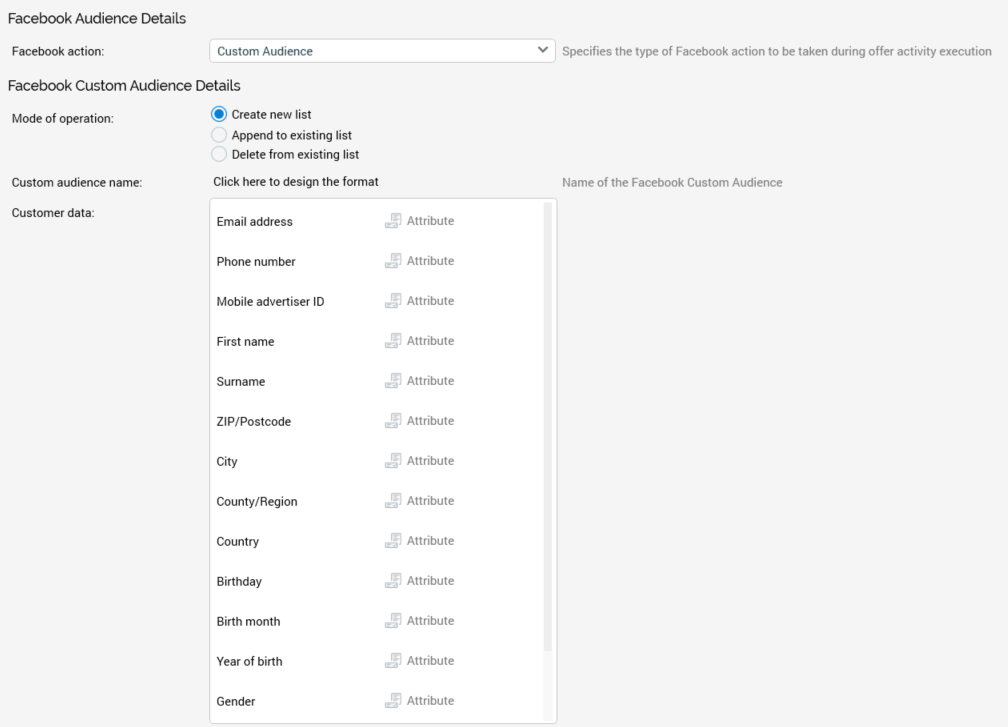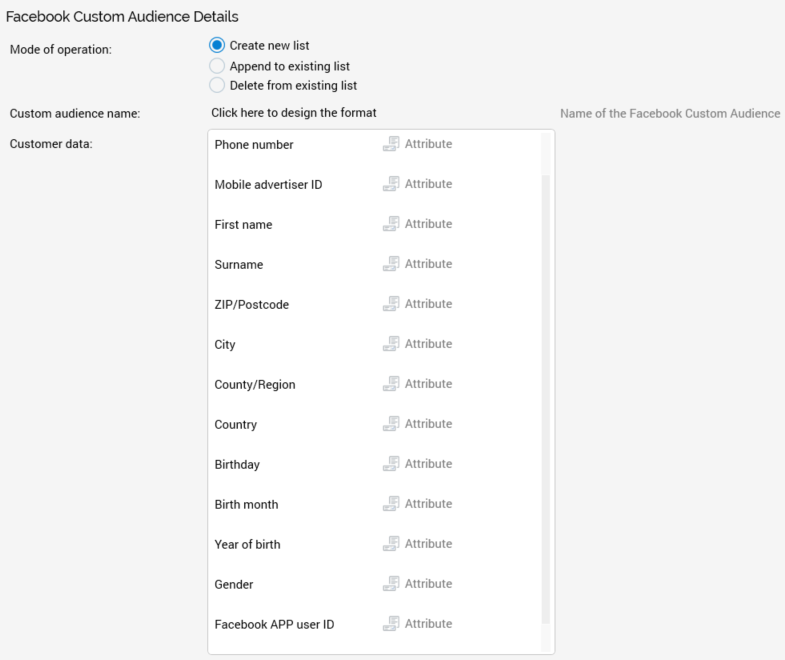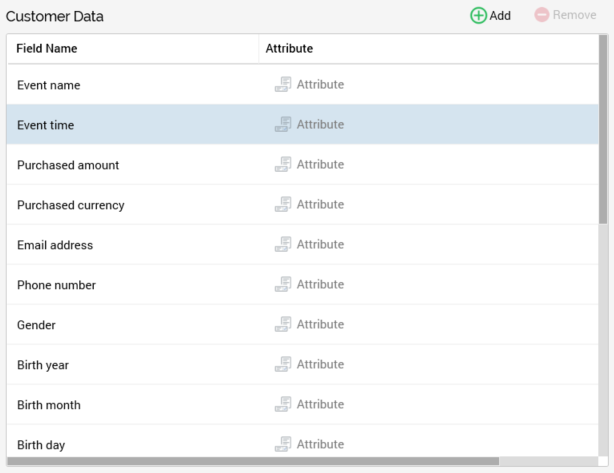Facebook Audience
Overview
The following properties are presented at a Facebook Audience offer.

Facebook Audience Details section
This section exposes a single property:

Facebook action: a dropdown, exposing the following values:
Custom Audience (the default)
Offline Event
The property allows you to specify the type of action to be taken at offer activity execution. Selection of value displays a series of properties to support the type of action to be undertaken.
Facebook Custom Audience Details section
This section is displayed when Facebook action is set to Custom Audience. It contains the following:

Mode of operation: three radio buttons accompany this property:
Create new list: this option is selected by default. When selected, Channel, Synchronize with Facebook, and Custom Audience are hidden, and Custom audience name is shown. When this option is selected, uploaded users will be added to a new custom audience (unless a custom audience with the name provided already exists).
Append to existing list: when selected, Channel, Synchronize with Facebook, and Custom Audience are shown, and Custom Audience name is hidden. When this option is selected, uploaded users will be appended to an existing custom audience.
Delete from existing list: when selected, Channel, Synchronize with Facebook, and Custom Audience are shown, and Custom Audience name is hidden. When this option is selected, uploaded users will be deleted from an existing custom audience.
Custom audience name: you can specify the name of a new Facebook custom audience to be created at offer execution using the Design Custom Audience Name Format dialog. The following text parts are supported:
String
Date part
Age range (requires Year of birth attribute to be provided at the Customer Data property)
Channel: this dropdown field is shown when Mode of operation is set to Append to or Delete from existing list. It is accompanied by, and populated on invocation of, a Synchronize with Facebook button. Clicking the button populates the field with a list of available Facebook Custom Audience channels.
Custom Audience: this editable combo box accompanies, and its dropdown values are populated at the same time as, Channel. It facilitates selection or specification of a Facebook custom audience to or from which user data will be appended or deleted (note that a manually-specified Custom Audience must exist in the list).
Customer data: this property is pre-populated with a list of Facebook field names. Each can be mapped to an RPI attribute file (using browse or drag and drop). Having mapped a field to an attribute, the attribute's details can be viewed in the File Information Dialog; the selection can also be cleared. At least one field must be mapped to an attribute.
The “Limited Data Use” field can be used to map a Boolean attribute, which controls whether a record is subject to Facebook’s feature of the same name. Its mapping is mandatory when “US states” has been mapped to an attribute (and vice versa).
App IDs: this text field is visible and mandatory when the Facebook app user ID field is mapped to an attribute. It allows you specify a comma-separated list of the Facebook app IDs associated with the Facebook app user ID.
Page IDs: this text field is visible and mandatory when the Facebook page user ID field is mapped to an attribute. It allows you specify a comma-separated list of the Facebook page IDs associated with the Facebook page user ID.
Facebook Offline Event Content section
This section is displayed when Facebook action is set to Offline Event. It contains the following:

Use existing: this checkbox allows you to specify whether execution of the offer will add users to an existing event. It is unchecked by default. When checked, Offline event name and Description fields are replaced with Channel and Offline Event dropdowns. Note that this feature has been discontinued for Facebook channels using API version 20 or above.
Offline event name: this property is shown when Use existing is unchecked. It can be a maximum of 100 characters in length and allows you to specify the name of the offline event.
Description: this property is shown when Use existing is unchecked. It can be a maximum of 1000 characters in length and allows you to specify the offline event's description.
Channel: this dropdown property is shown when Use existing is checked and allows you to select from a list of the Facebook Offline Event channels configured at the current RPI tenant.
Offline Event: this dropdown property is shown when Use existing is checked. It is populated at invocation of the Synchronize with Facebook button, which is shown to the right of the Channel dropdown. It allows you to choose from an existing Facebook offline event associated with the selected channel.
Upload tag: this mandatory text field can be a maximum of 100 characters in length, and represents the tag used to track event uploads.
Dataset ID: this mandatory text field, which accepts a maximum of 50 characters, allows you to specify the ID of the dataset associated with offline events. Details on how to set up a dataset ID can be found at: https://www.facebook.com/business/help/5818684664831465
Assign to ad account: this checkbox, which is unchecked by default, allows you to assign tracking and read permission to a Facebook Ad account.
Customer Data section
This section is displayed when Facebook action is set to Offline Event. It contains the following:

Toolbar: exposing the following:
Add: clicking this button adds a new custom entry to the Customer Data list.
Remove: this button is enabled when a custom entry is selected in the list. Selecting it removes the entry.
List: contains a list of predefined, and optionally custom, Customer Data. For each, Field Name and Attribute properties are shown. Field names are read-only for predefined data, and writeable for custom data. Event name and Event time are required. Each field must be mapped to an RPI Attribute.
